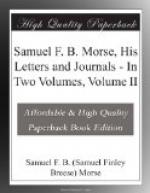He was, by nature, intensely enthusiastic, and his strong personality ever impressed itself on individuals and communities with which he came in contact. He was a born leader of men, and, like so many other leaders, often so forgetful of self in his eager desire for the general good as to seriously interfere with his material prosperity. This is what happened to him now, for he gave so liberally of himself in the formation of a new artistic body in New York, and in the preparation of lectures, that he encroached seriously on time which might have been more lucratively employed.
His brother Sidney comments on this in a letter to the other brother Richard: “Finley is well and in good spirits, though not advancing very rapidly in his business. He is full of the Academy and of his lectures— can hardly talk on any other subject. I despair of ever seeing him rich or even at ease in his pecuniary circumstances from efforts of his own, though able to do it with so little effort. But he may be in a better way, perhaps, of getting a fortune in his present course than he would be in the laborious path which we are too apt to think is the only road to wealth and ultimate ease.”
We have seen that Morse was one of the founders of an academy of art in Charleston, South Carolina, and we have seen that, after his departure from that city, this academy languished and died. Is it an unfair inference that, if he had remained permanently in Charleston, so sad a fate would not have overtaken the infant academy? In support of this inference we shall now see that he was largely instrumental in bringing into being an artistic association, over which he presided for many years, and which has continued to prosper until, at the present day, it is the leading artistic body in this country.
When Morse settled in New York in 1825 there existed an American Academy of Arts, of which Colonel Trumbull, the celebrated painter, was the president. While eminent as a painter, Trumbull seems to have lacked executive ability and to have been rather haughty and overbearing in his manner, for Morse found great dissatisfaction existing among the professional artists and students.
At first it was thought that, by bringing their grievances before the board of directors of the Academy, conditions might be changed, and on the 8th of November, 1825, a meeting was called in the rooms of the Historical Society, and the “New York Drawing Association” was formed, and Morse was chosen to preside over its meetings. It was not intended, at first, that this association should be a rival of the old Academy, but that it should give to its members facilities which were difficult of attainment in the Academy, and should, perhaps, force that institution to become more liberal.
It was not successful in the latter effort, for at a meeting of the Drawing Association on the evening of the 14th of January, 1825, Morse, the president, proposed certain resolutions which he introduced by the following remarks:—




